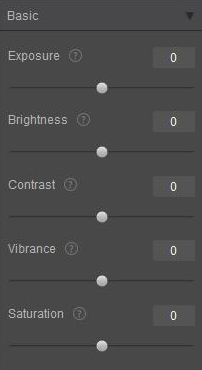Inverting B&w Images For Mac
Op Amp Bandwidth eCircuit Center Op Amp Bandwidth CIRCUIT Non-Inverting Amplifier Inverting Amplifier OPBANDWIDTH1.CIR Its all about speed - at least that's what this topic is about. In an ideal world, an op amp responds accurately and instantly to an audio or video signal. But in the real world, there's a limit on the highest frequency (bandwidth) and fasted edge your op amp can process. A few simple concepts provide insight into an amplifier's bandwidth. And knowing this can help you make better op amp and circuit choices. THE REAL STORY OF GAIN To understand bandwidth, we must understand the real gain equation.

You've probably seen the ideal Closed-Loop voltage gain equation for a non-inverting amplifier. But, what's the real story including the op amp's internal gain? It actually looks like this where A - open-loop gain - internal gain of the op amp itself. Β - feedback factor - how much of the output is fed back to the negative input Here's the beauty of this equation. Check out what happens to G CL if A is made large. For A (R2+R1) / R1, The bottom line? The gain is set by R1 and R2, not the op amp gain A!
( This fact certainly simplifies op amp circuit design.) And consequently, A can vary due to initial tolerances or temperature drift, but the voltage gain holds rock solid set by the resistor values! BANDWIDTH So what's the problem with the real gain equation? Although, A is large (+100,000) at lower frequencies, it falls at higher frequencies to well below unity ( 2. But when A drops close to G CL, the closed-loop gain takes a dive. Note where G CL begins to drop. The frequency where the voltage falls to 0.707 of its intended value is the cutoff or -3 dB frequency, fc.
( Gain in decibels = 20 ∙log(0.707) = -3dB. ) HANDS-ON DESIGN Pick a higher gain for this amplifier. Choose R2 somewhere in the range of 10 k to 10,000 k Ω.
Rerun the simulation. Yes, G CL looks great at low frequencies, but what happened to the bandwidth?

Because G CL is essentially bounded by A, the bandwidth fc gets smaller for a higher gain! Life and circuit design are full of compromise, and gain versus bandwidth is a fine example. Can you extend the bandwidth G CL?
Sure, make A larger by increasing its gain or bandwidth. The op amp model simulates the DC gain with EGAIN 3 0 1 2 100K.
Increase the 100k by a factor of 10 or so. Or, you can increase the bandwidth by decreasing RP1 or CP1 by a factor of 10. Run a new simulation. Did your new op amp extend the bandwidth at V(4)? NON-INVERTING BANDWIDTH How can you predict the bandwidth at any gain?
A simple equation gets you the answer. Fc = fu / G N where fu (Unity Gain Frequency) - the frequency where the open-loop gain A falls to unity (1V/V or 0dB). G N (Noise Gain) - the gain defined below. Also, equal to the inverse of the feedback factor 1/ β.
G N = 1/(R1 + R2) / R1 = 1/ β Why the name 'noise gain'? Typically, noise is modeled as a voltage source at the positive input of the amplifier. So the non-inverting gain is used to calculate the resulting output. Does the noise gain equation look familiar? The noise gain same as the signal gain for the non-inverting amplifier G N = G CL. For example, a non-inverting amplifier having a fu = 10 MHz and R1 = R2 = 10k gives a closed-loop gain G CL = 2 and a noise gain of G N = 2. Calculating its bandwidth fc, we get fc = fu / G N = 10 MHz / 2 = 5 MHz HANDS-ON DESIGN Run a few simulations with various voltage gains of OPBANDWIDTH1.CIR.
Plot the AC Response at the output at V(4) and A via the equation V(4)/(V(2)-V(1)). Adjust the gain by varying R2 and R1.
You should be able to predict the bandwidth at V(4) for any of your chosen gains. GAIN-BANDWIDTH-PRODUCT The term fu is also called the the Gain-Bandwidth-Product (GBP).
Why call it this? If we rearrange the above equation, we get fu = GBP = G N x fc Notice, that the product of gain G N and bandwidth fc is constant and bounded by GBP (fu)! What does this mean? You can't arbitrarily set the gain and bandwidth for a given op amp.
Increase the gain G N, and the bandwidth fc will drop to keep GBP constant. Alternatively, if you need a higher bandwidth, then you must choose a lower gain. If you need both higher gain and bandwidth, you're out of luck with this device. You need to pick an op amp with a higher GBP (fu) on its data sheet. THE INVERTING AMPLIFIER What about the inverting amplifier? The results are similar with a slight twist.
Let's start with it's closed-loop gain equation - significantly different than the non-inverting gain. Where A is the internal gain and the feedback factor is β = R1 / (R1+R2). Note, the feedback factor, β = R1 / (R1+R2), is the same for inverting or non-inverting amplifier. That's because β is simply the gain of vo to the neg input ( β = V- / Vo), just like the non-inverting amp. Similar to the non-inverting amplifier, when A is large, the ideal inverting gain is achieved. For A (R2+R1) / R1, However, as frequency increases and A drops close to the ideal gain, G CL begins to drop.
How do we predict this frequency where the gain falls off? Similar to the non-inverting amplifier we calculate fc = fu / G N The fc calculation also uses the noise gain. But here's the twist, the noise gain for the inverting amp is the same as the non-inverting amp! G N = (R1 + R2) / R1 = 1/ β For example, an op amp having a fu = 10 MHz and R1 = R2 = 10k gives an inverting gain of G CL = -1. However, the bandwidth is reduced by the noise gain G N = (R1 + R2) / R1 = 2 giving fc = GBP / G N = 10 MHz / 2 = 5 MHz Here's the disadvantage of the inverting amplifier: signals are amplified by the R2 / R1 ratio, but the bandwidth is knocked down by the larger ( R1+R2 ) / R1 ratio. CIRCUIT INSIGHT Try out the inverting amplifier in the OPBANDWIDTH1.CIR.
Plot the AC Response for the output V(14) and the op amp's internal gain V(14)/V(12). A log plot on the Y-Axis can give a better view. The gain should match the ideal -R2 / R1 as long as A is larger than (R1+R2)/R1. HANDS-ON DESIGN Crank up the gain by choosing R2 somewhere in the range of 10 k to 10,000 k Ω. Rerun the simulation.
For any gain, G CL should be bounded by A. Does the bandwidth get smaller as you increase gain? NON-INVERTING VS. INVERTING AMPLIFIER Here's a showdown between the two classic amplifiers.
The challenge is this: for the same gain, which amplifier has the greater bandwidth? We'll use a voltage gain of 2 for both circuits. Amplifier Gain Components Closed-Loop Gain G CL fu (GBP) Noise Gain G N Bandwidth fc = GBP / G N Non-Inverting R1 = 10 k R2 = 10 k (R1+R2) / R1 = +2 V/V 10 MHz (R1+R2) / R1 = 2 10 MHz / 2 = 5 MHz Inverting R1 = 10 k R2 = 20 k - R2 / R1 = -2 V/V 10 MHz (R1+R2) / R1 = 3 10 MHz / 3 = 3.3 MHz The bandwidth champion is the non-inverting amplifier!
Investing B W Images For Mac Download
However, this bandwidth difference is less for larger gains. Still, all other things being equal, choose the non-inverting amplifier to maximize your bandwidth.
Investing B W Images For Mac 2017
CIRCUIT INSIGHT Run a simulation of OPBANDWIDTH1.CIR. Set the resistors in the non-inverting and inverting amplifiers to values in the table above. Plot the AC output at V(4) and V(14). Did the non-inverting gain live up to expectations? Another way to measure circuit speed is how fast the amplifier responds to a step input.
Inverting Image Color

In the real world, the step input represents a quick brightness change in a video signal or the rising / falling edge of a clock signal. Run a simulation and plot the Transient Response at V(4) and V(14). How much faster does the non-inverting output reach 90% of its final value compared to the inverting output? MORE TO BANDWIDTH Although fu (GBP) and gain play a major role in determining bandwidth, there's more to it. Slew rate and heavy loading can cut into your bandwidth. Slew rate would not only make an interesting design topic, but a challenging as well. Its on the list of future topics.
SIMULATION NOTES For a more detailed description of the op amp, see the. For a quick review of subcircuits, check out? SPICE FILE or copy this netlist into a text file with the.cir extension.